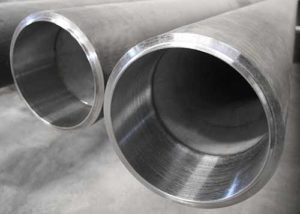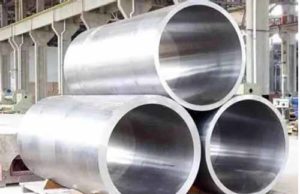Manufacturing process and application field of bimetal composite steel pipe.(HY-marketing department)
Metallurgical composite double (multi) metal steel pipe combines primary industrial materials with high-tech metallurgical processing, and uses high-quality centrifugal casting blank + extrusion (or hot rolling) + cold rolling (or cold drawing) Composite pipe. It can be a composite of general carbon steel and stainless steel (such as: 20# and 304), or it can be a composite of any steel with nickel, chromium and molybdenum alloys, and can also realize multi-layer composite of various metals according to user requirements. .
In summary, metallurgical composite double (multi) metal pipes are a new type of application pipe that is ideal for service in harsh environments or as an alternative to expensive single metal pipes.

Manufacturing process:
-
The bimetallic composite tube blank is prepared by a layered centrifugal casting method, and the two layers of metal are dissolved in a liquid state to achieve a true metallurgical bond;
-
The production process of hot-pressing (or longitudinally rolling) the bimetal composite tube blank into a seamless steel pipe by using a large-tonnage ferrous metal extruder (or a longitudinal rolling mill);
-
The high-precision cold-rolling pipe machine can be further used to roll the extruded seamless steel pipe into a precision composite pipe;
Technical features:
-
The centrifugal casting technology dissolves the two-layer material in a liquid state, realizes a gap-free interface and a smooth transition of the joint composition, and creates conditions for realizing the all-metallurgical combination of low stress at the interface interface;
-
Hot extrusion (or vertical rolling) processing technology not only promotes metallurgical bonding, but also improves the overall performance of bimetallic composite pipe;
-
Hot extrusion is the plastic deformation of metal under the condition of three-direction compressive stress, which is the preferred production mode of nickel base alloy which is difficult to produce by conventional rolling;
The extrusion product metal has high density, the micro defects are greatly reduced, and the product has high impact performance. At the same time, the hot extrusion process promotes the role of the diffusion bonding mechanism.

Product Features:
-
Selecting different grades of substrates allows the composite tube to achieve different mechanical properties;
-
Due to the metallurgical bond of the interface with a wide composition gradient, there is sufficient bonding strength between the substrate and the composite material, and the bonding layer has no stress concentration phenomenon;
-
The selection criteria can be based on API 5LD, QCX enterprise standard, or according to the user’s internal and external materials working conditions, such as: the outer layer is a general carbon steel, the inner layer is stainless steel , the outer layer implements the standard GB/T8162 “seamless steel pipe for the mechanism”, the inner layer implements the standard “stainless steel seamless pipe for fluid transportation” GB/T14976;
Performance advantages:
-
Maximally solve the problems of interface delamination, composite interface stress concentration, weld stress concentration (or inner weld seam cracking) and poor stress corrosion resistance in the traditional composite method;
-
Selecting composite materials with different properties can obtain excellent resistance to harsh environmental corrosion or wear and prolong the service life of steel pipes. If chloride stress corrosion cracking occurs, the crack propagation will stop with the substrate. The excellent corrosion resistance of the interface alloy is still very safe;
-
Because the strength of the composite layer of the composite pipe approximates the strength of the base metal, the stress of the pipe is the mechanical properties of both the base layer and the composite layer;
-
With good ductility and higher bonding strength than other types of composite pipes, can be easily reworked or various deformations, such as: the pipe can be directly extruded to manufacture pipe parts;
-
Can flexibly change the thickness of the base layer and the complex layer to meet the needs and needs of different industries;
-
Can save a lot of precious metal materials, especially in the field of high alloy tubes have a greater cost advantage;
Product category and application:
-
The base pipe is 10#, 20# and other carbon steel, combined steel and other steel, and the inner layer is composited with 13Cr, 304, 316, 0Cr25Ni20, Inconel 601 and other corrosion-resistant materials or nickel-based alloys, mainly used for the inner wall. Fluid and gas delivery pipelines with high corrosion resistance requirements and high strength requirements on the outer wall;
-
The base pipe is corrosion-resistant stainless steel or alloy steel, and the inner layer is compounded into carbon steel with high strength and combined steel, such as: 304L/20G, the outer layer is resistant to alkaline corrosion, and each layer is improved in strength against steam corrosion. It is mainly used for water-cooled wall tubes such as alkali recovery boilers (black liquor boilers) and biological waste furnaces in paper mills;
-
The base pipe is Cr5—Cr12 heat-strength steel and heat-resistant steel, and the inner layer is composited as corrosion-resistant stainless steel or alloy; it is mainly used for high corrosion resistance of the inner wall and low corrosion requirement of the outer wall. Fluid and gas delivery pipelines required for certain thermal strength;
-
Wear-resistant tube, the base layer is 16Mn, the inner layer is compounded with Cr15-Cr26 high-chromium cast steel. Mainly used in power plant pulverized coal, ash removal, slag removal pipeline; mine tailings filling, tailings storage, concentrate transportation, washing plant, and other high-wear working environments such as sandy oil and gas;


